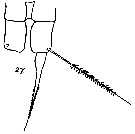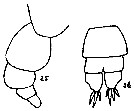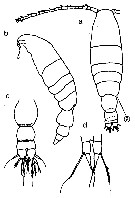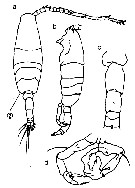|
|
 |
|
Calanoida ( Order ) |
|
|
|
Diaptomoidea ( Superfamily ) |
|
|
|
Acartiidae ( Family ) |
|
|
|
Acartia ( Genus ) |
|
|
|
Acanthacartia ( Sub-Genus ) |
|
|
| |
Acartia (Acanthacartia) tumida Willey, 1920 (F,M) | |
| | | | | | | Ref.: | | | Willey, 1920 a (p.21, Descr.F, figs.F); Brodsky, 1950 (1967) (p.427, figs.F,M); C.B. Wilson, 1950 (p.155, figs.F,M); Shih & al., 1971 (p.201); Chihara & Murano, 1997 (p.671, Pl.18, 19: F,M). |  Issued from : K.A. Brodskii in Calanoida of the Far Eastern Seas and Polar Basin of the USSR. Opred. Fauna SSSR, 1950, 35 (Israel Program for Scientific Translations, Jerusalem, 1967) [p.428, Fig.303]. Female (from Bering Sea): habitus (dorsal and lateral right side); R, rostrum; last thoracic segment and urosome (dorsal); S5, P5. Male: urosome (dorsal); S5, P5. Nota: Abdomen 5-segmented. Lateral bristle of distal segment of left P5 exceeding the segment in length, same segment bearing long apical spine.
|
 issued from : C.B. Wilson in Bull. U.S. natn. Mus., 1950, 100 (14) (4). [Pl.20, Figs.271-274]. Female (from W Aleutian Islands: Attu Island): 271, habitus (dorsal); 273, P5. Nota: Head and 1st thoracic segment separated, 4th and 5th fused. Corners of 5th thoracic segment rounded. Urosome 3-segmented, half as long as the metasome. Genital segment as long as the two abdominal segments combined, its lateral margins convex. Anal segment wider than long with straight sides, incised at the center of the posterior margin. A1 just reaching the posterior of the thorax and rather sparsely setose. Exopod of A2 scarcely longer than the basal segment of the endopod. Md with 1 large acute outer tooth separated from the others and a row of smaller teeth across the end diminishing in size inwardly. P5 uniramose, 3-segmented, basal segments totally fused across the midline; middle segments subrectangular and slightly curved, with a large plumose seta at the outer distal corner; 3rd segments globular at the base and then narrowed into a long acuminate curved blade, which is perfectly smooth. Male: 272, habitus (dorsal); 274, P5. Nota: Head and 1st thoracic segment separated, 4th and 5th fused. 5th thoracic segment with rounded posterior corners. Urosome 4-segmented, as long but only a third as wide as the metasome. Genital segment wider than the abdomen, with strongly convex margins, making it a little wider than long; middle and anal segments with straight sides. Caudal rami 1/2 longer than wide and nearly as long as the anal segment. A1 reaching the middle of the genital segment.A2, mouth parts, and first four pairs of legs like those of the female. P5 uniramose, 4-segmented, relatively long and slender; basal segment of the right leg bent at right angles, 2nd segment with a long seta on the posterior surface at about the center; the 3rd segment with a large triangular process on the inner margin; 4th segment curved into a half circle, with a small terminal seta and another near the center of the concave margin. The basal segment of the left leg is very short and has s short seta at the inner distal corner; the 2nd and 3rd segments each carry an outer seta, while the 4th segment is split and each portion is tipped with a large terminal seta.
|
 issued from : A. Willey in Rep. Can. Arct. Exp. 1913-18, 1920, VII, Part K. [p.21K, Fig.27]. Female (from 54°30'N, 159°42'W): 27, P5. Nota: Basal segments, right and left, parallel; the terminal segment (representing the endopodite) has a swollen proximal portion followed by a narrow neck, upon the distal part of which there commence 2 rows of small denticulations pointing distally. These denticulations are evenly disposed, increasing slightly and then diminishing in size, to be continued upon the proximal half of the attenuating setiform process. This delicate and regular serrulation is quite different from the coarse denticulation figured for Acartia tonsa where the teeth are few in number, the proximal largest.
|
 issued from : A. Willey in Rep. Can. Arct. Exp. 1913-18, 1920, VII, Part K. [p.21K, Figs.25, 26]. Female: 25, end of thorax and urosome (lateral); 26, urosome (ventral). Nota: A1 not exceeding length of forebody, reaching as far as the front part of the genital segment (when laid back). Rostral filaments present, widely separated in ventral view. Labrum large, trilobate with ciliate edges (as figured by Sars for A. longiremis).
Lateral borders of last thoracic segment smooth.
Urosome smooth, some minute points dorsally near the posterior edge of the genital segment and at posterior edge of the pre-anal segment.
A1 without thorns.
Caudal setae broken, some of their swollen basal parts remaining attached to the short and broad rami.
In the swimming legs, the terminal seta of exopod much longer than the exopodal segment 3, longer than the whole endopod, with a strongly serrated outer edge (arrangement of the setae as in A. clausi.
|
 Issued from : M. Chihara & M. Murano in An Illustrated Guide to Marine Plankton in Japan, 1997. [p.676, Pl. 18, fig.11 a-d]. Female: a, habitus (dorsal); b, same (lateral); ; c, urosome (dorsal); d, P5. Nota: numbers show characteristics of this species to compare with A. steueri, A. fossae.
|
 Issued from : M. Chihara & M. Murano in An Illustrated Guide to Marine Plankton in Japan, 1997. [p.677, Pl. 19, fig.11 a-d]. Male: a-b, habitus (dorsal and lateral); c, urosome (dorsal) without caudal rami; d, P5. Nota: numbers show characteristics of this species to compare with A. steueri, A. fossae.
|
 Issued from : M.S. Kos in Field guide for plankton. Zool Institute USSR Acad., Vol. II, 1976. After Brodsky, 1950. Female: 1-2, habitus (dorsal and lateral, frespectively); 3, abdomen (dorsal); 4, P5. Male: 5, abdomen (dorsal); 6, P5.
| | | | | Compl. Ref.: | | | Sewell, 1948 (p.496); Nishiyama & Hirano, 1983 (p.159, Table 4: length-weight); Nagasawa & Nemoto, 1985 (p.81); Hassett & al., 1993 (p.515); Seki & Shimizu, 1997 (p.21); Bragina, 1999 (p.196); Choi & al., 2005 (p.710: Tab.III); Ohtsuka & al., 2008 (p.115, Table 5); Hopcroft & al., 2009 (p.9, Table 3); Galbraith, 2009 (pers. comm.); Hopcroft & al., 2010 (p.27, Table 1, 2); Matsuno & al., 2011 (p.1349, Table 1, abundance vs years); Ohashi & al., 2013 (p.44, Table 1); Questel & al., 2013 (p.23, Rem. p.31); Coyle & al., 2014 (p.97, table 3); Chiba S. & al., 2015 (p.968, Table 1: length vs climate) | | | | NZ: | 4 | | |
|
Distribution map of Acartia (Acanthacartia) tumida by geographical zones
|
| | | | Loc: | | | Bering Sea, Chukchi Sea, off NW Alaska, Japan Sea, Tokyo Bay, Hokkaido, Aleutian Is., G. of Alaska, Vancouver Is. | | | | N: | 16 | | | | Lg.: | | | (22) F: 2,1-2; M: 1,8; (137) F: 2,25; M: 2,1; (190) F: 2; (866) F: 2-2,7; M: 1,8-2,1; {F: 2,00-2,70; M: 1,8-2,10}
Chiba S. & al., 2015 (p.971, Table 1: Total length female (June-July) = 2.0 mm [optimal SST (°C) = 7.3]. | | | | Rem.: | coastal, ± brackish.
Diffusion possible by ship's ballast water. | | | Last update : 11/04/2020 | |
|
|
 Any use of this site for a publication will be mentioned with the following reference : Any use of this site for a publication will be mentioned with the following reference :
Razouls C., Desreumaux N., Kouwenberg J. and de Bovée F., 2005-2025. - Biodiversity of Marine Planktonic Copepods (morphology, geographical distribution and biological data). Sorbonne University, CNRS. Available at http://copepodes.obs-banyuls.fr/en [Accessed October 20, 2025] © copyright 2005-2025 Sorbonne University, CNRS
|
|
 |
 |










